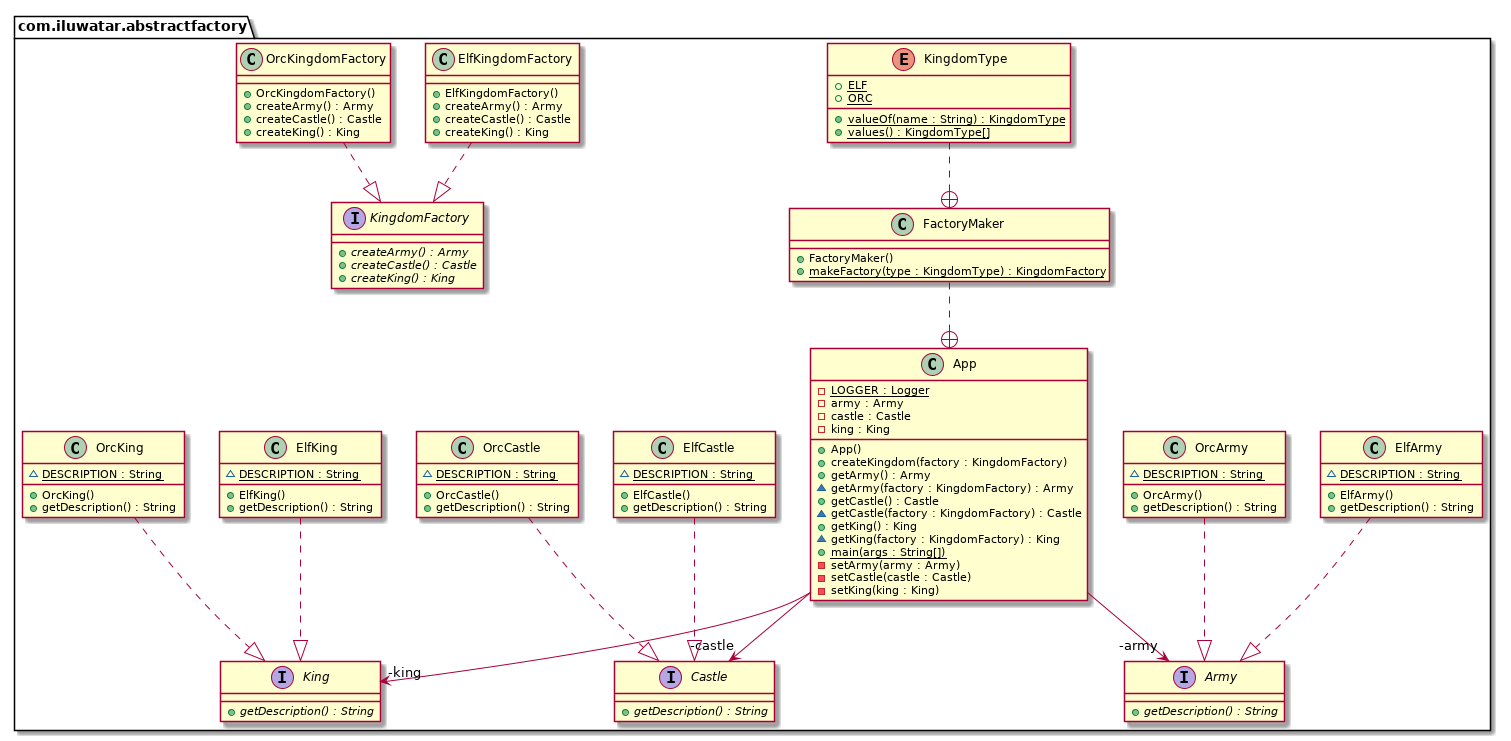Intent
Provide an interface for creating families of related or dependent objects without specifying[指定] their concrete[具体] classes.
Explanation
Real-world example
Imagine a furniture[家具] company that produces various styles of furniture: modern, Victorian[维多利亚时代], and rustic[乡村的]. Each style includes products like chairs, tables, and sofas. To ensure[确保] consistency[一致性] within each style, the company uses an Abstract Factory pattern.
In this scenario[脚本], the Abstract Factory is an interface for creating families of related furniture objects (chairs, tables, sofas). Each concrete factory (ModernFurnitureFactory, VictorianFurnitureFactory, RusticFurnitureFactory) implements the Abstract Factory interface and creates a set of products that match the specific style. This way, clients can create a whole set of modern or Victorian furniture without worrying about the details of their instantiation[实例化]. This maintains[保持] a consistent style and allows easy swapping[交换] of one style of furniture for another.
In plain words
A factory of factories; a factory that groups the individual[单独的] but related/dependent factories together without specifying their concrete classes.
Wikipedia says
The abstract factory pattern provides a way to encapsulate[概括、封装] a group of individual factories that have a common theme without specifying their concrete classes
Programmatic Example
To create a kingdom we need objects with a common theme. The elven[精灵] kingdom needs an elven king, elven castle, and elven army whereas[而、反之] the orcish[兽人] kingdom needs an orcish king, orcish castle, and orcish army. There is a dependency between the objects in the kingdom.
Translating the kingdom example above. First of all, we have some interfaces and implementation for the objects in the kingdom.
public interface Castle {
String getDescription();
}
public interface King {
String getDescription();
}
public interface Army {
String getDescription();
}
// Elven implementations ->
public class ElfCastle implements Castle {
static final String DESCRIPTION = "This is the elven castle!";
@Override
public String getDescription() {
return DESCRIPTION;
}
}
public class ElfKing implements King {
static final String DESCRIPTION = "This is the elven king!";
@Override
public String getDescription() {
return DESCRIPTION;
}
}
public class ElfArmy implements Army {
static final String DESCRIPTION = "This is the elven Army!";
@Override
public String getDescription() {
return DESCRIPTION;
}
}
// Orcish implementations similarly -> ...Then we have the abstraction and implementations for the kingdom factory.
public interface KingdomFactory {
Castle createCastle();
King createKing();
Army createArmy();
}
public class ElfKingdomFactory implements KingdomFactory {
@Override
public Castle createCastle() {
return new ElfCastle();
}
@Override
public King createKing() {
return new ElfKing();
}
@Override
public Army createArmy() {
return new ElfArmy();
}
}
// Orcish implementations similarly -> ...Now, we can design a factory for our different kingdom factories. In this example, we created FactoryMaker, responsible for returning an instance of either ElfKingdomFactory or OrcKingdomFactory. The client can use FactoryMaker to create the desired[所需] concrete[具体] factory which, in turn, will produce different concrete objects (derived[来源] from Army, King, Castle). In this example, we also used an enum to parameterize[用参数表示] which type of kingdom factory the client will ask for.
public static class FactoryMaker {
public enum KingdomType {
ELF, ORC
}
public static KingdomFactory makeFactory(KingdomType type) {
return switch (type) {
case ELF -> new ElfKingdomFactory();
case ORC -> new OrcKingdomFactory();
};
}
}Here is the main function of our example application:
LOGGER.info("elf kingdom");
createKingdom(Kingdom.FactoryMaker.KingdomType.ELF);
LOGGER.info(kingdom.getArmy().getDescription());
LOGGER.info(kingdom.getCastle().getDescription());
LOGGER.info(kingdom.getKing().getDescription());
LOGGER.info("orc kingdom");
createKingdom(Kingdom.FactoryMaker.KingdomType.ORC);
LOGGER.info(kingdom.getArmy().getDescription());
LOGGER.info(kingdom.getCastle().getDescription());
LOGGER.info(kingdom.getKing().getDescription());The program output:
07:35:46.340 [main] INFO com.iluwatar.abstractfactory.App -- elf kingdom
07:35:46.343 [main] INFO com.iluwatar.abstractfactory.App -- This is the elven army!
07:35:46.343 [main] INFO com.iluwatar.abstractfactory.App -- This is the elven castle!
07:35:46.343 [main] INFO com.iluwatar.abstractfactory.App -- This is the elven king!
07:35:46.343 [main] INFO com.iluwatar.abstractfactory.App -- orc kingdom
07:35:46.343 [main] INFO com.iluwatar.abstractfactory.App -- This is the orc army!
07:35:46.343 [main] INFO com.iluwatar.abstractfactory.App -- This is the orc castle!
07:35:46.343 [main] INFO com.iluwatar.abstractfactory.App -- This is the orc king!Class diagram

Applicability
Use the Abstract Factory pattern when:
- The system should be independent of how its products are created, composed[组成], and represented[表达方式].
- You need to configure the system with one of multiple families of products.
- A family of related product objects must be used together, enforcing[加强] consistency.
- You want to provide a class library of products, exposing only their interfaces, not their implementations.
- The lifetime of dependencies is shorter than the consumer's lifetime.
- Dependencies need to be constructed using runtime values or parameters.
- You need to choose which product to use from a family at runtime.
- Adding new products or families should not require changes to existing code.
Tutorials
Consequences
Benefits:
- Flexibility: Easily switch between product families without code modifications.
- Decoupling: Client code only interacts with abstract interfaces, promoting portability and maintainability.
- Reusability: Abstract factories and products facilitate component reuse across projects.
- Maintainability: Changes to individual product families are localized, simplifying updates.
Trade-offs:
- Complexity: Defining abstract interfaces and concrete factories adds initial overhead.
- Indirectness: Client code interacts with products indirectly through factories, potentially reducing transparency.
Known uses
- Java Swing's
LookAndFeelclasses for providing different look-and-feel options. - Various implementations in the Java Abstract Window Toolkit (AWT) for creating different GUI components.
- javax.xml.parsers.DocumentBuilderFactory
- javax.xml.transform.TransformerFactory
- javax.xml.xpath.XPathFactory
Related patterns
- Factory Method: Abstract Factory uses Factory Methods to create products.
- Singleton: Abstract Factory classes are often implemented as Singletons.
- Factory Kit: Similar to Abstract Factory but focuses on configuring and managing a set of related objects in a flexible way.
1 条评论
意象选取精妙,营造出空灵意境。